
October 2025
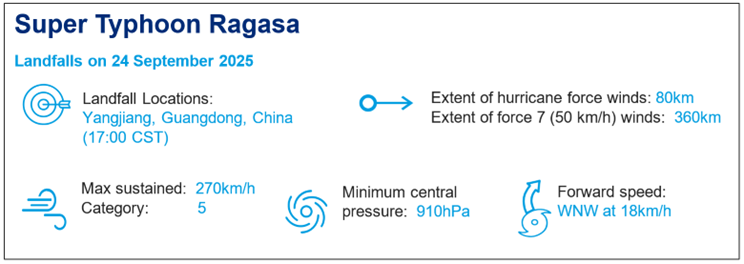
Summary
- Super Typhoon Ragasa was the strongest typhoon in the Western North Pacific in 2025. It made landfall in Yangjiang, Guangdong Province of China as a severe typhoon.
- Ragasa brought widespread heavy rainfall to the Philippines and the eastern side of Taiwan.
- Emergency measures substantially mitigated the threat posed by the typhoon in Mainland China and Hong Kong SAR.
- While Ragasa was of similar strength to recent typhoons, such as Mangkhut (2018), it tracked further away from major cities, which also helped to reduce its damage.
- Typhoon formation has been higher than normal in the Western North Pacific basin in 2025, driven by prevailing La Niña conditions.
POST-EVENT REPORT: 2025 WESTERN NORTH PACIFIC TYPHOON RAGASA
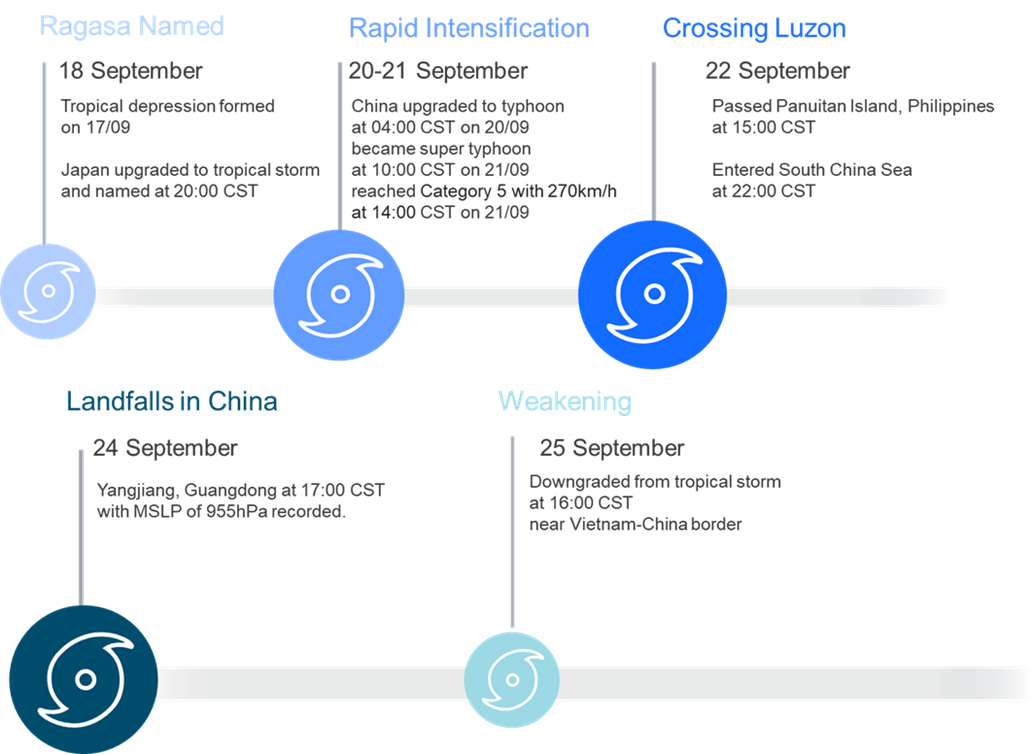
Meteorological History
Super Typhoon Ragasa (known as “Nando” in the Philippines) is the 18th named tropical cyclone of the Western North Pacific in 2025. Ragasa is strongest tropical cyclone this year, reaching Category 5 with maximum sustained winds of 270 km/h (145 knots).
Ragasa originated from a low-pressure system about 1,000 km east of the Philippines. The system attained tropical storm status on 18 September and was named by the Japan Meteorological Agency. After its formation, the system moved west-north-westward across the Philippines Sea and the northern part of the South China Sea.
On 21 September, Ragasa became a Category 5 typhoon on the Saffir-Simpson Hurricane Wind scale or a Super Typhoon using the China classification as it travelled across warm ocean waters exceeding 29°C and a weak vertical wind shear environment.
The typhoon passed Luzon Strait on 22 September, and its broad circulation generated heavy rainfalls in Luzon and Taiwan. The system entered the South China Sea the next day and continued tracking westward toward the South China coast.
As Ragasa moved closer to landmass from 23 September it gradually weakened. In the early morning of 24 September, the typhoon passed about 120 km to the south of Hong Kong. Winds over 120 km/h and heavy rainfall were recorded in parts of the city. Ragasa later made landfall near Yangjiang, Guangdong province at 5 pm CST the same day, with estimated maximum wind speeds of 145 km/h. Yangjiang National Weather Station had a new strongest wind gust of 54.5 m/s (196 km/h) recorded, surpassing the previous record set by Typhoon Hagupit in 2020. Offshore weather stations nearby also reported wind gusts exceeding 60 m/s (215 km/h).
The storm continued moving westward and weakening on 25 September. Its remnants brought heavy rain to northern Vietnam and Laos.
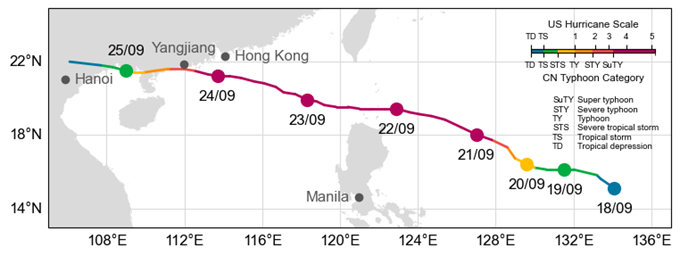
Damage Impacts
Philippines
The typhoon brought in destructive winds and caused severe flooding the northern Luzon, as it hit Panuitan Island in the Philippines’ northern Cagayan province on 22 September. Ragasa exacerbated the existing monsoon, resulting in flooding and landslides that damaged properties as well as bridges and roads. Thousands were evacuated from villages and schools, and at least 11 people were killed. The Disaster Risk Reduction and Management estimated the initial agricultural loss of PHP 565 million (USD 9.7 million) on 25 September.
Taiwan
Torrential rains associated with Ragasa caused a barrier lake to overflow in Hualien County on 23 September. As of reporting on 5 October, 18 people had been killed and 6 remained missing. The Ministry of Agriculture estimated the agricultural damages to be NTD 599 million (USD 19.7 million).
Hong Kong and Macau
A total of 101 people were injured in Hong Kong, including 3 that were swept into the sea by waves associated with the typhoon in the eastern side of Hong Kong Island. Coastal locations were impacted by rough seas and high waves, causing damages to some waterfront properties.
In Macau, low-lying areas were flooded with water levels as high as 1.5m, where power supplies were suspended. More than 3,000 people were evacuated, and 8 people were injured.
Mainland China
Yangjiang City, Guangdong province, was severely damaged as the typhoon hit directly. Aquaculture planks and floating boxes disintegrated, valuable deep-sea fish products were swept into the sea in Hailing Island, an offshore island of Yangjiang. An aquaculture company suffered damage to nearly 1,600 acres of sheds during the typhoon, with some farmers’ board houses being directly blown away and mattresses being lifted and blown into the shed ponds.
At least 5 wind turbines were broken, with turbine blades damaged. Photovoltaic panels covering an area of 1,700 acres had been damaged in strong wind and rain, with some panels being blown and deformed, and iron nets flying off. More than 500,000 households experienced power outages.
In Zhuhai, coastal areas were impacted by the storm surge, more than 60 thousand people were evacuated. 865 shelters were opened in Shenzhen, with 260 thousand people evacuated. The city reported the strongest winds since Typhoon Mangkhut in 2018.
National Development and Reform Commission has allocated CNY 200 million (USD 28 million) from the central budget to support Guangdong Province in post-typhoon recovery. The typhoon also triggered the Yangjiang Catastrophe Index Insurance, with Yangjiang Finance Bureau receiving a prepayment of CNY 4.2 million (USD 590 thousand) from the leading underwriting department for post-disaster relief.
Emergency Measures and Risk Mitigation
Mainland China
While Typhoon Ragasa is one of the strongest typhoons to hit Guangdong, the damages reported are minimal thanks to the government’s emergency managements implemented in the province.
- More than 2.22 million people were relocated to safe areas, focusing on vulnerable populations, low-lying zones and temporary worker shelters.
- Flood control emergency response was initiated at Level IV and upgraded to Level II, with 78 mobile water conservancy rescue teams totalling 2,153 personnel pre-positioned and on standby.
- Provincial emergency supplies worth approximately CNY 124 million (USD 17 million), including pumping equipment and tarpaulins, were pre-positioned and distributed to key areas such as Yangjiang and Maoming.
- By the evening of the 23 September, more than 16 regions in Guangdong implemented the “five suspensions” (suspending school, work, production, business operation and transportation), including Guangzhou, Shenzhen, Zhuhai, Foshan, Huizhou, Shanwei, Dongguan, Zhongshan, Jiangmen, Yangjiang, Zhanjiang, Maoming, Zhaoqing, Chaozhou, Jieyang.
- Several intercity railways in Guangdong suspended operations. To ensure safe passenger travel, the Guanghui, Guangzhao, Guangqing, Guangzhou East Ring Intercity Railway and the entire Guangzhou Metro network (including trams) suspended operations from 24 September, with subsequent operational measures dynamically adjusted based on the typhoon situation.
- A total of 23 large professional rescue ships, 117,000 rescue team members, and 94,000 sets of rescue equipment were pre-positioned, and professional forces from emergency, maritime, water conservancy and transportation departments were coordinated to prepare for rescue operations.
Nearby provinces such as Hainan, Guangxi and Fujian also suspended transport services prior to the typhoon.
Hong Kong
Hong Kong Observatory warned the public of an upcoming typhoon similar to Mangkhut (2018) as early as 1 week ahead. The government ordered preparatory works to mitigate possible serious threats including:
- Emergency centres and response teams were set up and ready for operation to monitor and handle emergencies during heavy winds.
- Hong Kong International Airport was closed for 36 hours.
- Drains in flood-prone areas were inspected and cleared. Defensive and preventive measures were in place to deal with flooding, landslides and fallen trees across the city. More than 200 response teams were ready to deploy in case of flooding.
- Construction and property management teams implemented preventive measures to ensure construction sites, glass windows and facades, and photovoltaic panels were safe and secure.
- 50 temporary shelters were opened, with schools and offices shut one day ahead of Ragasa.
Historical Comparison
Guangdong is a typhoon-prone area, expecting 5 to 6 tropical cyclones every year. Table 1 compares Typhoon Ragasa with recent significant typhoons impacting Greater Bay Area: Saola in 2023, Mangkhut in 2018 and Hato in 2017.
While Typhoon Ragasa made landfall with similar intensity to the typhoons mentioned above, it tracked further away from the major cities like Hong Kong and Shenzhen. With better typhoon measures and mitigation, lower economic losses than those experienced from previous typhoons are expected.
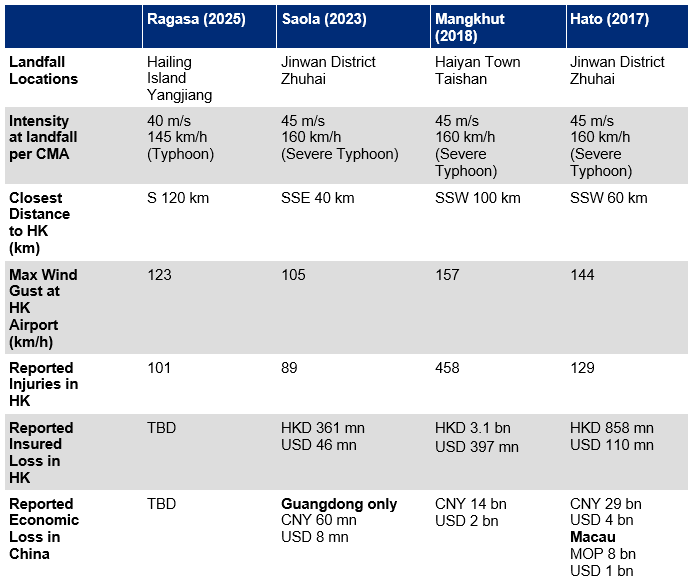
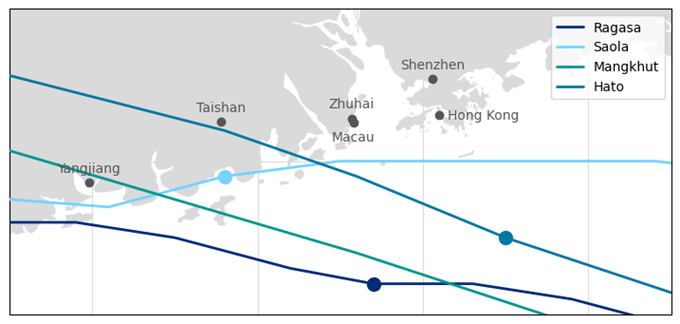
As of 8 October, 10 named tropical cyclones have already impacted the south China coast and northern Vietnam, far more than the annual average of 5 to 6 per year. While it is generally expected that in a warmer climate typhoons can reach higher wind speeds and generate heavier precipitation, assessing the total influence of climate change on tropical cyclones especially their frequency and movements remains challenging.
According to Hong Kong Observatory, this above average typhoon season can be attributed to La Niña-like weather patterns throughout the Northern Hemisphere summer. Warmer-than-usual ocean waters in the western Pacific have fuelled tropical cyclone formations, with persistent easterly flows across the northern South China Sea and the Philippines Sea steering the storms towards the south China coast. Typhoon Ragasa has nevertheless proved that timely disaster preparation can minimise the impact of tropical cyclones.
Sources: China Meteorological Administration, Hong Kong Observatory, Joint Typhoon Warning Center, AP, Al Jazeera, British Broadcasting Corporation, Central News Agency (Taiwan), China Central Television, Macau Daily, New Zealand Chinese Herald, Red Star News (China), Sing Tao Daily (Hong Kong), South China Morning Post (Hong Kong), Strait Times (Singapore), Ta Kung Pao (Hong Kong), Wen Wei Po (Hong Kong), Xinhua News Agency (China).